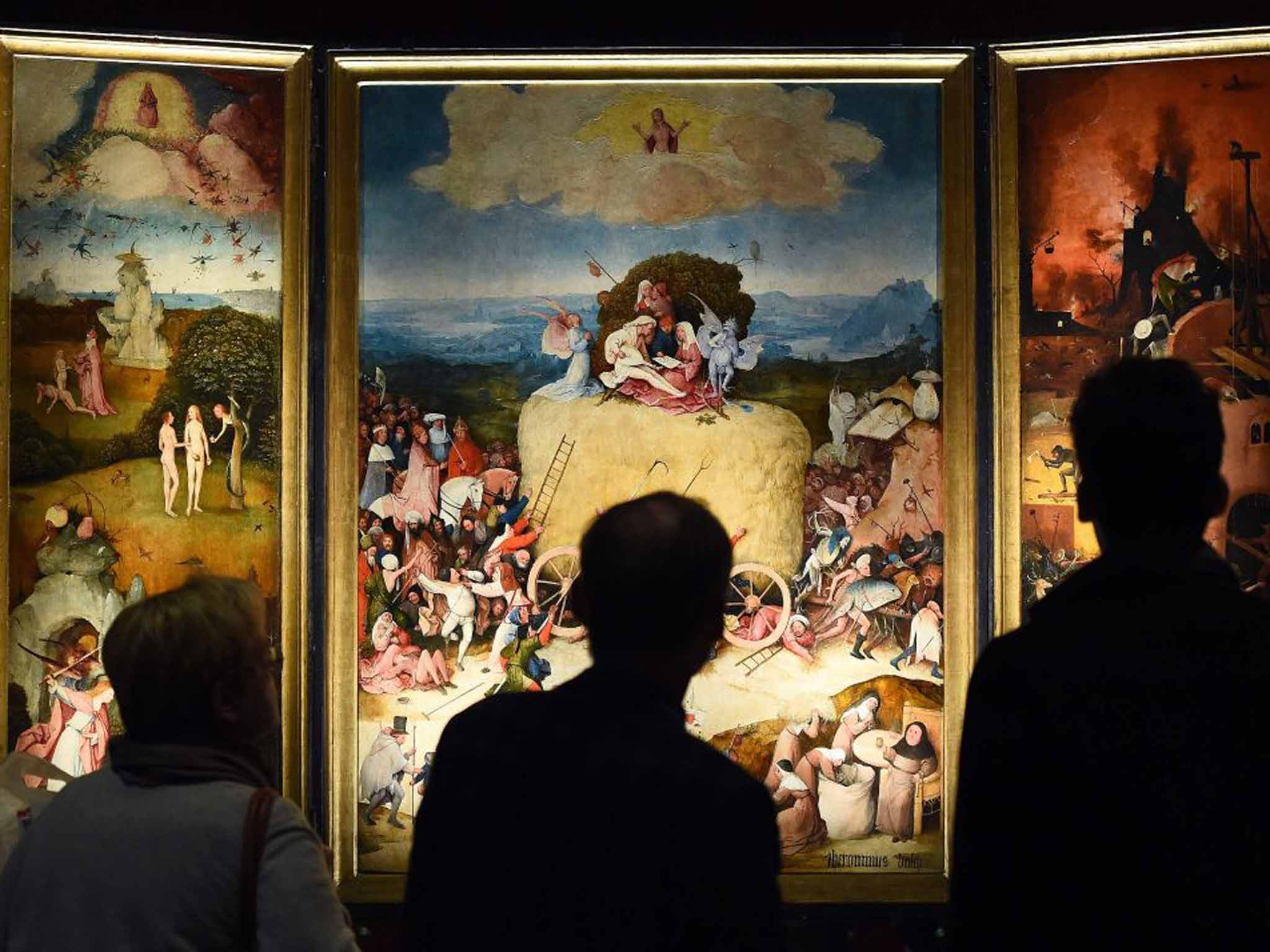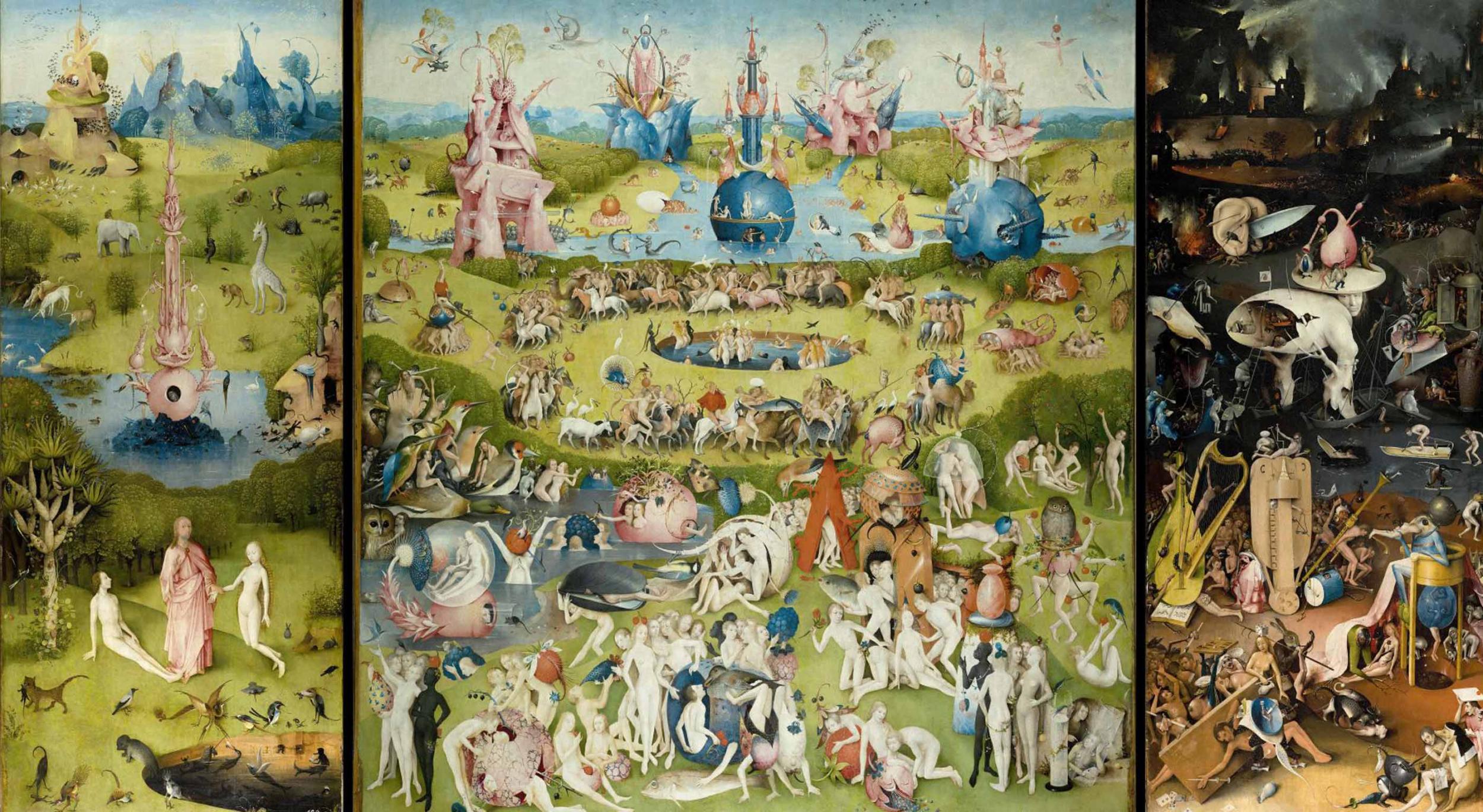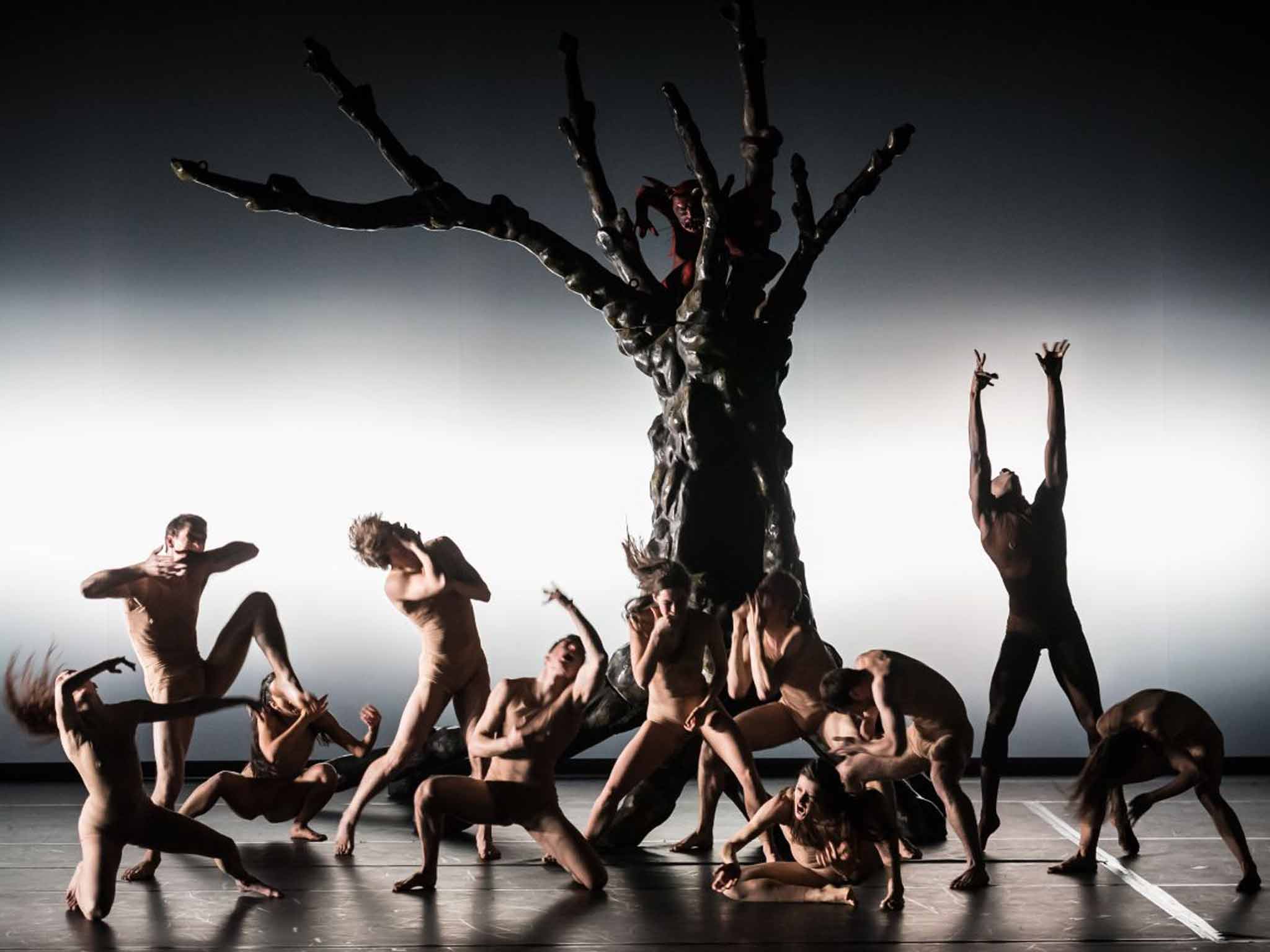Hieronymus Bosch retrospective: An apocalyptic prophet, an explorer of the unconscious, and a perverse fantasist
An influence even now, ahead of a major retrospective of the artist's work, Boyd Tonkin asks if the real Hieronymus Bosch could please stand up

Art galleries sometimes try to enthuse junior visitors with quests and hunts that encourage them to spot a single item – a parrot, a red hat, a lemon tree, perhaps – in the paintings on the walls. After a day spent with Hieronymus Bosch, I can tell you with some confidence which creature to trace across the oil-on-oak panels and pen-and-ink drawings now gathered for a unique celebration of his work in his home city of 's-Hertogenbosch, in Brabant in the southern Netherlands.
Forget, for the moment, the crazy hybrids, the monstrous couplings of man and fish, monk and monkey, barrel and bum, quadruped and kitchenware that have intrigued and obsessed Bosch's critics for most of the five centuries since he died, in the town where he had always lived, in 1516. For me, after several hallucinatory circuits of the rooms where Het Noordbrabants Museum has assembled an unrepeatable haul of 20 paintings and 19 drawings, none of these much-publicised proto-surrealist mash-ups felt like the true stuff of nightmares. No: it was a simpler species that made the flesh creep. If you want to be properly spooked by Bosch, follow the owls.
Take the panel of St Jerome at Prayer, lent by the Museum of Fine Arts, in Ghent. That hermit saint was the namesake of the artist born Jeroen van Aken – the moniker “Hieronymus Bosch” served as smart branding, much like Banksy or Gilbert and George – and a favourite subject of his. Here, the tonsured scholar stretches out with a miniature crucifix next to a mammoth rotting strawberry: a symbol of fleshly lusts, the Bosch analysts suggest. Behind him, on a hollow fallen tree-trunk with a fish-like open maw, an owl glares at the viewer. Nearby, gazing from a pitch-black cavity, another owl betrays its presence by the merest yellow hints of eyes and beak – three quick flicks of the brush in the murk.
Sinister birds of night and ill-omen rather than serene symbols of wisdom, Bosch owls fix you with their gimlet eyes when every other figure – whether human, animal, angelic, demonic, or a mix-and-match unknown to zoology – is otherwise engaged. In Ecce Homo, from the Frankfurt museum, that trademark Bosch crowd of scoffers and jeerers turn their misshapen mugs up towards Jesus with his crown of thorns. But what's that peering out towards us from the alcove in a brick wall next to the soon-to-be crucified saviour? A half-concealed owl, of course, who for some reason cares more about our reaction to the scene than the world-shaking Biblical drama a few feet away.
Whether erudite, esoteric or plain wacky, far-fetched theories pile on Bosch like the outsize bells, helmets and funnels that stifle his tormented sinners. So why not add to the heap? Staring at the spectator while everyone else goes to hell in a handcart (quite literally), the owls feel almost like a signature. A well-known drawing, The Woods have Ears, the Fields Have Eyes, shows an ever-vigilant owl lurking in the hollow of a tree. Scholars read it as a coded coat-of-arms.

In the Hermit Saints triptych from Venice, St Jerome (again) prays to his crucifix in the ruins of a pagan palace. On the arm of a smashed throne – a painting-within-a-painting – a stick emerges from the arse of a man whose top half is stuck inside a basket. On the stick sits a little owl. Alone in this scene, the bird looks directly at us. Jeroen or Hieronymus, our beady-eye harbinger of doom, brings us the bad news about human folly, and the damnation that awaits heedless humanity, then asks with an owlish hoot: what are you going to do about it? Mend your ways, pals. And who's the real bird-brain here?
From hidden owls to giant self-starting clogs, walking fish to massive human-skewering knives, the exhibition in 's-Hertogenbosch marks five centuries since the artist's death with an unprecedented round-up of his dream-like bestiary. Charles de Mooij, director of the Noordbrabants Museum, comments that, “Even Bosch himself probably never saw so many of his works together at one time.”
De Mooij began to assemble this great homecoming party in 2007. However, Den Bosch (to give the town its more tourist-friendly unofficial name) possessed not one surviving work by its most famous son. De Mooij approached the museums that did – from Kansas City to Venice, Boston to Berlin – with an offer that almost none refused. Lend us your precious Bosch and we will build up, through standardised research techniques that range from infrared photography to computerised image-analysis, a body of expertise that refines and defines our understanding of this still-enigmatic figure. As De Mooij says, “If we couldn't offer any artwork” in return for the loan of a rare treasure, “then we could perhaps offer knowledge of Bosch and his world.”
It worked. Until May, this cosily attractive small city in Brabant has custody of 20 painted panels out of the 24 we know, and 19 out of 21 drawings. Among Bosch's star turns, only the Garden of Earthly Delights cannot move from its home at the Prado in Madrid. Instead, a high-quality near-contemporary copy shows how quickly Bosch's reputation spread through 16th-century Europe.
As the mayor, Ton Rombouts says, this is “a once-in-a-lifetime opportunity” to experience the vast majority of Bosch's surviving works “in the city in which they were painted”. Over the coming months, Bosch-themed sound-and-light shows, interactive tours, site-specific performances and even a heaven-and-hell boat trip along the ancient canals, will make the most of an unspoiled urban landscape. As the mayor puts it, in the 21st century, “With blindfolded eyes, Hieronymus Bosch could find his way through the city streets.”
Since 2010, the nine experts of the Bosch Research and Conservation Project have cast new light on the mysterious master-painter who lived and worked in a house that still stands – four doors from a McDonald's – on the market square. One of their procedures, designed by computer scientist Robert Erdmann, updates the so-called “Morelli method” of authenticating artworks by the close examination of small details: ears, hair or fingers, for example. Soon to go live, the open-access website boschproject.org will allow users to sample its digital storehouse of Bosch-related imagery. If I can face their haunting gaze again, I will be having another peek at those owls.
The Bosch who emerges from this hi-tech scrutiny belongs more to his age than the wizard of fantasy who beguiled admirers in the past. He comes across not so much as a pioneer Surrealist, psychedelic shaman or Freudian precursor as a satirical religious moralist whose dark wit and wild imagination served fairly conventional forms of piety. The son of a painter, brother to three more, Jeroen van Aken aka Hieronymus Bosch took over the family business and pursued it with no crises or disruptions that history records.

Ensconced for decades on the market square, he joined the elite Illustrious Brotherhood of Our Lady and found many patrons through this pious Rotary Club. He also sought and won commissions further afield: notably, from Philip the Fair of Burgundy, overlord of this prosperous municipality that had grown rich – like so many others in the Low Countries – on the cloth trade. Even the name he chose to sign his works served to drum up new business, De Mooij explains: “Potential clients in other cities would know where to find him.” Want a Bosch? Come to Den Bosch. The shop's right on the square.
So the visionary artist whom CJ Jung called “the discoverer of the unconscious” spun his visions on the loom of a sedate and rather bourgeois late-medieval life. He married the well-to-do Aleid van der Meervenne, went on painting, ran a busy workshop, and never lost the respect of his clients. On 9 August 1516, the Brotherhood paid for a Requiem Mass in St John's Cathedral for the late “sworn member” of their inner circle. If the stay-at-home genius did go on a pilgrimage (a recurrent motif in his art), then he travelled not on the roads of the Low Countries but purely in the mind's eye.
Traditional proverbs or Biblical injunctions often drive the delirious profusion of the paintings. The Haywain, which has left Spain for the first time in 450 years, seems to erect its head-spinning carnival of pride, greed and lust on top of a trite maxim: “The world is a hay-cart and everyone takes what they want from it.” Yet no other painting with this theme precedes it. From the old chestnut, Bosch carved revolutionary art, as heedless humankind chases pleasure and profit around the mortal hay-cart planted between paradise and hell. And what's this lightly painted creature that perches on a stray branch and observes, not the canoodling lovers in the tree beneath it, but us? An owl, of course.
In the gulf between the grey life and the florid work, monsters of speculation grew. His early champions saw in Bosch's visions the sort of moralising satire that still gives modern scholars a key to the works. To the theologians of Habsburg Spain, which harvested art treasures from Burgundian lands, Bosch scourged sin and folly with a corrective whip. In 1605, the monk José Sigüenza insisted that “If there are any absurdities here, they are ours, not his.”
Only later did the notion of Bosch as freaky, head-tripping fantasist take hold. Jungians and Freudians found in his graphic anatomical mishaps the symptoms of a troubled or fixated personality. Erika Fromm, sternly setting the old Dutchman on her couch, detected in The Garden of Earthly Delights the “polymorphous perverse” fantasies of an impotent homosexual who exposed his “fears about genitality”. To Laurinda Dixon, the same triptych represents a secret allegory of alchemy, as base metal becomes gold. Most influentially, for hippie-era Bosch fans, in 1947 Wilhelm Fraenger argued that Bosch did not warn against the erotic frolics he depicts but rather celebrates them as a higher form of innocence. This mystical Bosch supposedly belonged to the heretical Brotherhood of the Free Spirit and encoded its libertarian teachings in his work.
On top of the free-love Bosch came the Surrealist Bosch. The presence of major paintings in Madrid certainly had an impact on the young Salvador Dali. His imagery blurs the boundaries between life and non-life, animate and inanimate existence, organic softness and mineral hardness, in Bosch-like ways. So clear is the link that Dali had to protest the contrary. “I am the anti-Hieronymus Bosch,” he implausibly claimed.
Other Surrealists, such as Joan Miró and Leonora Carrington, imagined hybrid beasties that would fit snugly into the teeming margins of a Bosch panel. Later, the Garden of Earthly Delights became a favourite pop-art allusion, in record shop as well as gallery. Deep Purple's third album lifted it as a cover illustration in 1969. The Prado was not amused. That vogue arrived just after a 1967 exhibition in Den Bosch, which had for the first time brought a significant number of works back to his birthplace. It attracted not the expected 30,000 visitors but more like 300,000. In the year that psychedelia went mainstream, many young Europeans detected in Bosch a kindred spirit who revelled in altered states of mind.
Every modern generation has found a Bosch to suit its fads and fancies. In the era of world wars and then Cold War, Bosch the apocalyptic prophet came to the fore. His vistas of torture and execution, his burning towers and shattered citadels, not only seemed to belong to the morbid late-medieval end-game evoked by Dutch historian Johan Huizinga in his classic study The Waning of the Middle Ages. They foreshadowed a 20th-century mood of doom.
More recently, the Indian-born British painter Raqib Shaw has reimagined the Garden... as an underwater phantasmagoria. The American digital artist Carla Gannis reconceives Boschian states of bliss and misery for a gadget-toting generation in her Garden of Emoji Delights. In film, shades of Bosch stalk the sets where Guillermo del Toro directs neo-Gothic extravaganzas such as Pan's Labyrinth. And, as with every marketable Master, the merchandisers have also got to work. Even Dr Martens has printed the Garden... on boots and bags.
As it plants the pious master-craftsman in his time and among his peers, the anniversary show delivers a more sober, more sociable and (dare one say it?) slightly less scary Bosch. Through 2016, the astute entrepreneur will be earning hard cash for his home town again in the year-long Bosch 500 programme. Among its highlights, the organisers have commissioned leading artists of today to respond to his visions with new works. Later in the year, creators such as Peter Greenaway and Jake and Dinos Chapman will unveil Bosch-inspired inventions. A few of these spin-offs have already taken shape. At the municipal theatre, I saw a preview performance of Hieronymus B: a dance work devised by the Dutch choreographer Nanine Linning and performed by her company.
Like many Bosch admirers, Linning asked herself: “What would happen if these images came alive?” Her show makes it happen. “I love centaur-like works,” she says, “part-animal and part-human.” Outsize frames and panels surround a dark stage. Out of them emerge the chimeras that Bosch painted in all their eerie, sinister glory. They move among the spectators as if in some chemically assisted dream. A woman slinkily emerges from a giant ear. A hybrid boat-man drifts among the crowd. A demon climbs down to accost the sinners. And what is this supersized bird that looms in front of me, brandishing a huge key? Inevitably, an owl. Five centuries after he left the house on the market square, Jeroen aka Hieronymus can still unlock the door to ecstasy – and terror. µ
'Jheronimus Bosch: Visions of Genius' continues at Het Noordbrabants Museum, 's-Hertogenbosch, The Netherlands, until 8 May: www.hnbm.nl. Full details of the Bosch 500 events are at www.bosch500.nl
Join our commenting forum
Join thought-provoking conversations, follow other Independent readers and see their replies
Comments